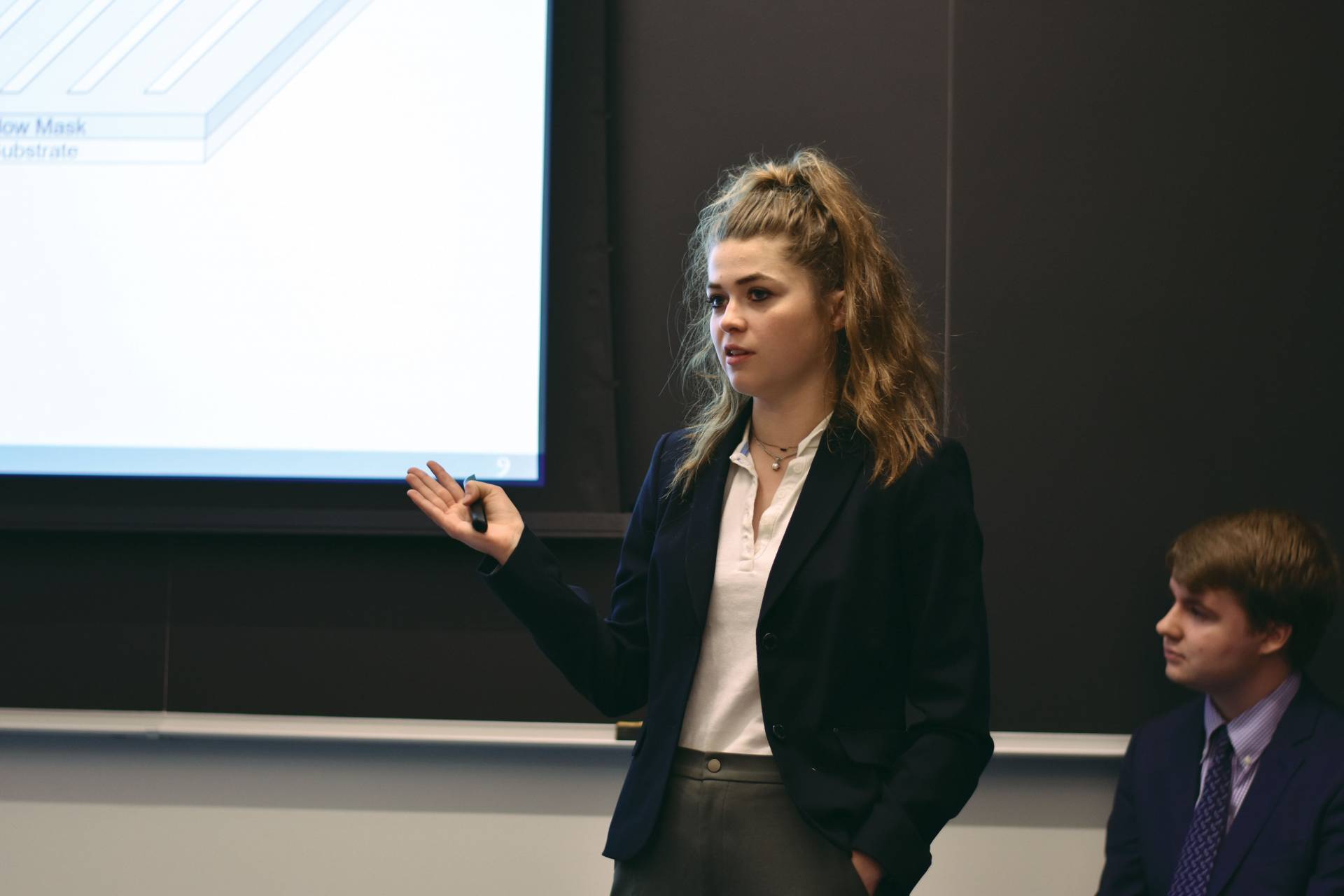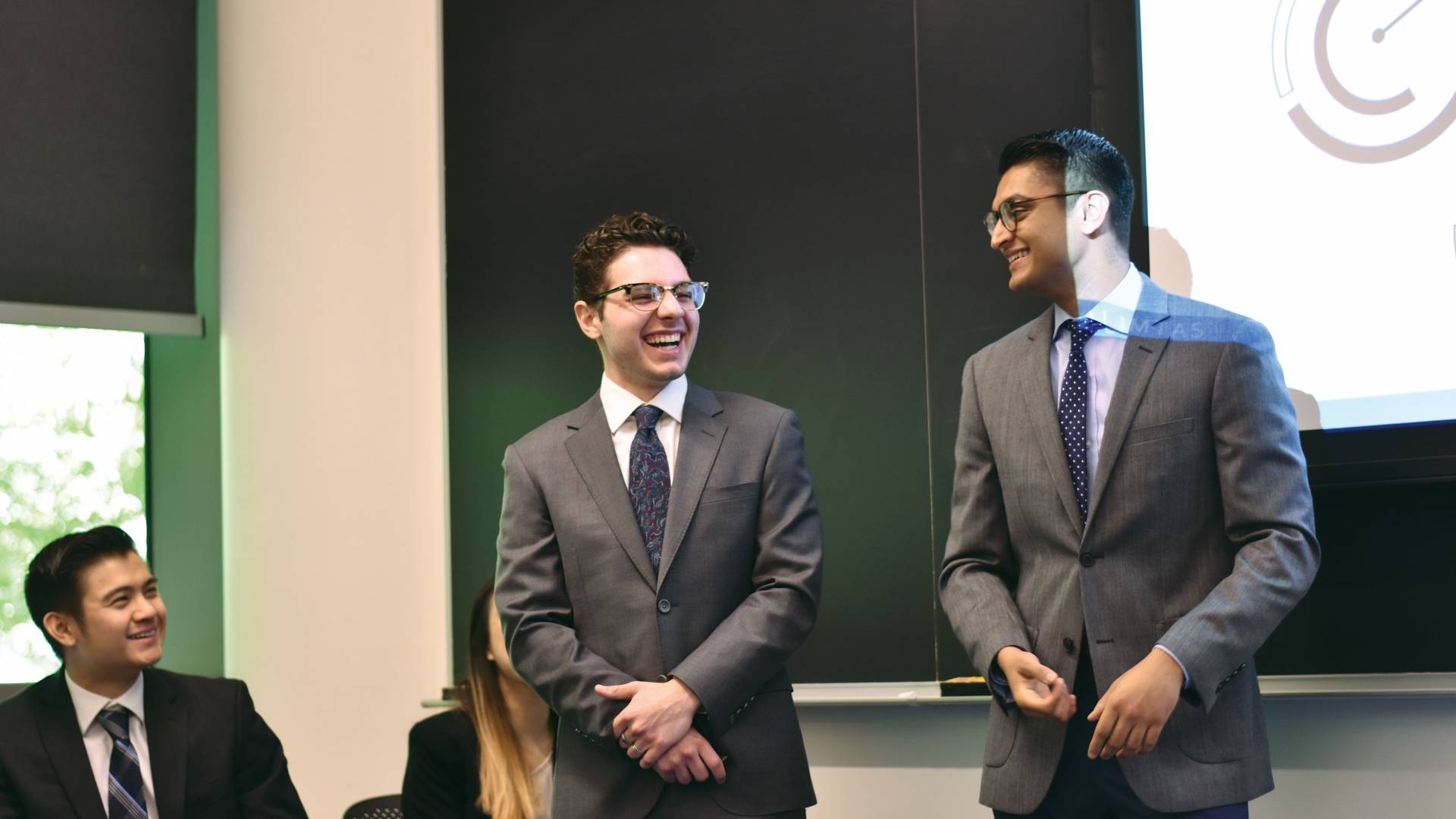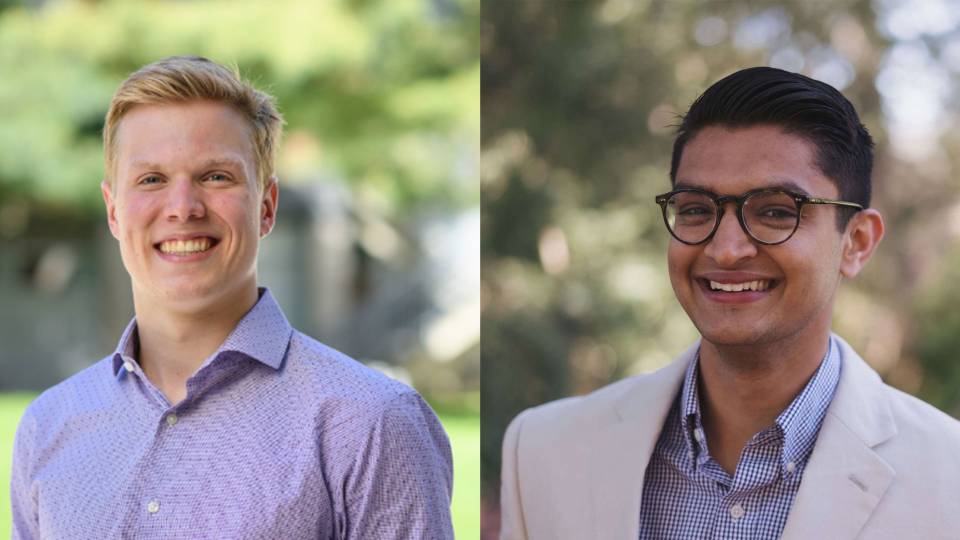Princeton Entrepreneurship Club member Ryan Yao (left), Class of 2021, listens to a presentation by Niko Fotopoulos (center), Class of 2021, and Rohan Shah (right), Class of 2020. The students are members of the club's Alimtas BioVentures, a team that performs due diligence and develops fundraising pitches for technology developed by Princeton faculty.
In front of a collection of industry representatives, Princeton faculty, staff and fellow students in early June, a new sub-team of the Princeton Entrepreneurship Club named Alimtas BioVentures capped a year of unprecedented entrepreneurial work at the University. Alimtas, a self-managed team of Princeton undergrads, formed a multidisciplinary team to perform due diligence and develop a fundraising pitch deck for a technology developed by Princeton faculty.
This is notable, because this is the type of project that MBA students normally undertake as part of their curriculum. But Alimtas did it, outside of class, on top of full course loads.
“This sort of program — teams of students working with a tech transfer office to build out a business plan around a real university technology — is relatively commonplace at business schools, and frequently a credited course in an MBA program,” said Tony Williams, New Ventures Associate at the Office of Technology Licensing. “For a group of undergraduate students to self-organize, and undertake the same work entirely under their own initiative and in their own free time is something completely unheard of (at least for me).”
Rohan Shah, Class of 2020; Avinash Boppana, Class of 2021; and Niko Fotopoulos, Class of 2021, met last year over their great interest in life sciences. Shah is a recipient of the Slavin Family Fellowship for students pursuing entrepreneurship across the country. Fotopoulos had already spent last summer at Princeton Innovation Center BioLabs with his own medtech startup Blackwell, but the three of them were looking for more ways to do hands-on learning. They wanted something more than just inviting speakers to come in, but something less than starting an entire biomedical company.
They sought out advice and input from people around campus, including Anne-Marie Maman, executive director of the Princeton Entrepreneurship Council, who advised them to start with one of Princeton’s own technologies as a basis for developing a process for their teamwork.

Kiersten Marr, Class of 2021, talks to faculty, staff and students during an Alimtas BioVentures presentation in June.
When the five-year, $10 million partnership between the University and the New Jersey Health Foundation to commercialize promising research coming out of Princeton was announced last October, they found their opportunity. “We could partner with the Office of Tech Licensing and help them do the due diligence and business model creation around some of the technologies that they identified,” said Shah.
With support from NJHF and other sponsors, they assembled ten more like-minded students and partnered with OTL on technology from the lab of Professor Jeffrey Schwartz in the Department of Chemistry. As the team formed, Anne-Marie Maman connected them to Andrew Wood, commercial transformation lead, Global Human Health at Merck. Wood guided them through the strategy and business considerations around the technology, providing feedback and an industry perspective. “What we do at Merck is look at a lot of opportunity. And we went through an exercise in understanding how to structure the opportunity that was in front of them,” said Wood.
Alimtas examined two applications of cellular patterning technology from the lab. The first centers around generating model organs in order to test new cosmetic products. Layers of cells can be arranged to create a model of a cornea that mimics its structural properties. This corneal model would replace rabbit and bovine corneas, currently used to test eye irritation and penetration results of cosmetics. This new alternative model would be significantly cheaper and faster to use, and would not require the use of animals.
The second application is the use of a regenerative medicine tool to help grow cells after spinal cord injury. When tissue within the body is damaged, the healing mechanism of scarring produces a non-optimal alignment of cells. Scar tissue has abnormal properties and does not function like original, healthy tissue. Using the patterning technology from the Schwartz lab and tested in the lab of Jean Schwarzbauer, the Eugene Higgins Professor of Molecular Biology, a scaffold with a patterned surface that guides cells to an optimal alignment can be created, resulting in normal, healthy tissue.
Alimtas projects a two-year timeline for the corneal model development process, with costs ranging from $5 to $10 million. For the regenerative medicine tool, the typical development process to reach the full-scale commercial product stage would take 10 years, with a cost upwards of $30 million. By bundling these two applications together, they suggested staging the development, with the earlier revenue from the corneal model development being used to support the cost of the medical device development.
After a year of collaborating with the faculty members, the Office of Technology Licensing, and Andrew Wood and other advisers, the team built a strong understanding of the technology and the business around it.
The Alimtas team delivered their business plan and due diligence presentation at the Frick Chemistry Building, an appropriate choice considering that the building itself was built using royalties from the cancer drug Alimta, which originated at Princeton, and was the inspiration for the team’s name. Among the attendees was Austin Mejia, Class of 2021 and the incoming E-Club co-president, who noted that the first year of a project can be the most challenging. “I am so amazed by everything Alimtas accomplished this year,” he said. “Now that they’ve established themselves, I anticipate next year to be even stronger and I’m incredibly excited to help support it. I have full faith in Alimtas to succeed.”
The Alimtas team was invited to meet with representatives from Arch Venture Partners in Chicago at the end of June, where they received constructive feedback. "Our meeting with Arch was incredibly informative and will certainly improve not only the technology but also the Alimtas organization,” said Shah. “Arch really made us think through our assumptions, strategies and business model."
While in Chicago, the Alimtas team also met with Jason Pariso, Class of 1999, director of the George Schultz Innovation Fund at the Polsky Center for Entrepreneurship and Innovation at the University of Chicago.
Looking forward, Alimtas BioVentures will expand. “For next year, we will be applying our methodology to multiple projects in parallel, exploring an array of exit opportunities, as well as preparing for a change of leadership as next year comes to a close,” said Boppana.
Increasing involvement from students and industry will also be a focus. “The student engagement is important,” said Wood. “It’s something that we should continue to drive. I also like the idea of bringing in other companies and capability sets.” The team also plans to pitch future work to other life science venture capital firms in Boston and San Francisco.
The full Alimtas team is Rohan Shah, Class of 2020 (molecular biology); Niko Fotopoulos, Class of 2021 (molecular biology); Avinash Boppana, Class of 2021 (computer science); Kiersten Marr, Class of 2021 (neuroscience); Ty Gardner, Class of 2020 (molecular biology); Insiya Essani, Class of 2020 (chemistry); Michael Hallee, Calss of 2021 (computer science); Sarah Lin, Class of 2022 (molecular biology); Ryan Thorpe, Class of 2022 (electrical engineering); Brian Kang, Class of 2022 (chemical and biological engineering); Nathan Alam, Class of 2021 (chemical and biological engineering); and Ryan Yao, Class of 2021 (computer science).







